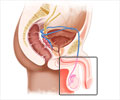Highlights
- The current tests for asthma include physical examination and measuring of lung capacity which may not be 100% accurate.
- These tests can be cumbersome and distressing and lead to misdiagnosis of the condition and unwanted medication.
- The metabolic profiling of saliva could be a one stop diagnosis for asthma.
- Saliva test is painless and provides information on the progression and severity of the condition.
The research team, led by Professor Colin Creaser from Loughborough's Department of Chemistry and Dr Dominick Shaw from the Respiratory Research Unit at City Hospital collected saliva from 30 patients, with and without asthma.
The saliva samples were assessed for metabolic biomarkers by performing liquid chromatography-mass spectrometry (LC-MS) analysis.
The new test diagnoses asthma by detecting the presence and the amount of the biomarkers. Sampling methods used in the study had the potential to pinpoint the severity and progression of the disease.
Asthma is a condition caused by narrowing of the bronchial tubes, the passageways that allow air to enter and leave the lungs. The airways become inflamed and secrete extra mucus. This makes breathing difficult and causes shortness of breath, wheezing and coughing.
Asthma Statistics
- Around 100 to 150 million people worldwide suffer from asthma with the number steadily rising. According the Center for Disease Control, one in 14 people has asthma. Asthma kills around 180,000 people annually.
- In America, the number of asthmatics has increased by 60% since 1980. Around 24 million Americans have asthma with children accounting for 8.6 % of the cases and adults at 7.4 %.
- While 5.4 million people in the UK currently receive treatment for asthma out of which 1.1 million are children. 8% of the Swiss population and 4 million people among the Germans are asthmatics.
- In Japan, 3 million people are diagnosed with asthma and in Australia, one in six children below 16 years of age are affected.
- In India, 15-20 million people have asthma with a prevalence of 10 to 15% among 5-11-year-old children.
The findings were published in the journal Analytical Methods.
Common Triggers of Asthma
Asthma can be triggered by substances that cause allergy, called allergens. The common allergens include pollens, dust mites, rodents, cockroaches, animal fur etc.When an allergen enters the body, it activates the immune system. The immune system responds by releasing the immunoglobulin E (IgE) which leads to inflammation of the airways, making breathing difficult. This can trigger asthma attack.
- Irritants in the air like smoke from cigarette, chemicals, smoke from fumes etc can also trigger asthma.
- Sometimes asthma can occur as a part of respiratory illness like cold, flu, sinus infection and pneumonia.
- Psychological triggers like grief, shock, crying, laughing, anger and excitement can also cause asthma.
- Sudden changes in weather and certain medicines are also associated with asthma.
- Exercise induced bronchoconstriction also triggers asthma in people who are prone to it. Exercise demands increased supply of oxygen to the body. As a result the person inhales through the mouth causing the air to be cooler and dryer as compared to nasal inhalation. The cool air causes the constriction or narrowing of the bronchial tubes, making breathing difficult.
Management of Asthma
- Early identification of the condition through proper physical examination by an asthma specialist or allergist.
- Use of appropriate long-term or quick relief medications depending on the severity of the condition.
- Avoid triggers which maybe environmental like cigarette smoke, pollens or dust, emotional triggers or certain medications that irritate and inflame the airways.
- Improving the quality of life through healthy diet, maintaining healthy weight, exercise and immunizations.
- Asthma Basics - (http://www.mayoclinic.org/diseases-conditions/asthma/basics/definition/con-20026992)
- Asthma Information for Patients - (http://www.aafa.org/page/asthma.aspx)
- Bronchial Asthma - (http://www.who.int/mediacentre/factsheets/fs206/en/)














